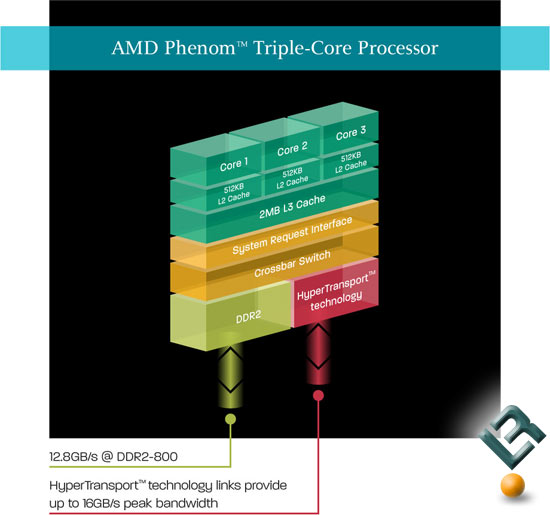AMD Triple Core – Marketing Hype or Mainstream Killer?
Neutered Quad-Core or Pocket Rocket?
When AMD announced they were coming out with a triple-core processor in the Phenom family of processors in Q1 2008, it caught many in the industry off guard. It turns out that AMD changed course a bit at the eleventh hour and managed to come up with an interesting gameplan to keep competitive with Intel in the months ahead. After the past few quarters its clear that AMD needs to get the momentum back in the desktop market and triple-core Phenom processors might just do the trick.

AMD has come out with the industries first native quad-core processor with Barcelona, but AMD has not been able to get the clock frequencies high enough on these quad-core processors to compete with Intel’s 45nm quad-core Yorkfield processors on a clock for clock basis. From our understanding, some engineers inside AMD noticed that during die testing at the FAB, that there was an occational frequency mis-match among cores. When AMD does see a problem core or when the frequency mis-match among cores, they now have the triple core option to keep from scrapping or down-grading that die. Let’s take a step backwards here: AMD tests each processor and when they do they test each of the four cores individually. By doing so, AMD has the ability to make sure that each core is working correctly and at what clock frequency. If AMD is trying to produce say, 2.6GHz Phenom processors, this is what happens. The processor is tested and, for example, it was found to have three cores running fine at 2.6GHz and one core that can do just 2.0GHz. AMD has the choice to fuse the processor at the silicon level (well before the integrated heat spreader is put on) as a 2.0GHz quad-core Phenom, or they could fuse it as a 2.6GHz triple-core Phenom if they wanted to lose the use of a core. AMD believed that a triple-core processor is a smart move for AMD as they can offer them at a competitive price point, while at the same time offering a processor with higher clock speeds than otherwise possible. Since the processors are ‘fused’ at the silicon level during production, our sources inside AMD say that attempts to ‘unlock’ the turned off core will be impossible from the outside by simply connecting pins or something like that.

According to Mercury Research, quad-core processors represented less than two percent of desktop shipments in Q2 2007. So, with the slow move to quad-cores combined with the fact very few mainstream software applications use four cores, AMD took the bold step to go for higher frequency and disabling the fourth core. To be honest, triple-core processors are not unheard of as the Microsoft Xbox 360 has triple-core architecture and as a result, the games are being designed for this hardware structure. By shutting down one core, all the dynamic L3 cache is still available, but it will be available to three cores and not four. In reality, this means each core has access to 8.33% more cache if each core has instruction sets that place them under full load. This might actually help performance in cases where more cache is beneficial to performance.

Since AMD hasn’t shown any benchmark numbers to the media, nor released what clock frequencies the triple-core Phenoms will be set to operate, a lot is up in the air. One thing is for certain though, AMD will be releasing these triple core processors and has them on the roadmap for Socket AM3 in 2009. Since AMD was so tight lipped about this launch it’s sure to have been a bit of a curve ball for Intel. For months everyone was reporting on lackluster clock frequencies on Barcelona and Phenom, but all of a sudden AMD can pull off higher clocks, cut prices and has a triple-core offering. You, of course, lose a core, but do you really need four cores today? That’s the point AMD is trying to drive home and if the price is right the marketing drive might win some people over. Which makes you think, if triple-core takes off and AMD’s customers orders a ton of them, will AMD be able to keep up with the orders? AMD has said that Barcelona and Phenom yields are good, so if that isn’t a lie they might have an issue with producing these in mass quantities. AMD would then be forced to either turn down sales or disable good quad-cores to fill orders. For some reason, I don’t see AMD scavenging good quad-cores to sell less expensive parts to save sales. I guess we will find out what happens in 2008!
Legit Bottom Line: AMD’s Phenom Triple-Core processors are quad-core Barcelona processors with one core ‘fused’ not to work. The end result is higher clock speeds and better performance on applications that aren’t threaded for 4+ cores.

Comments are closed.